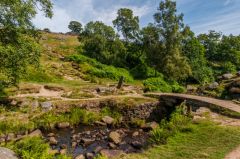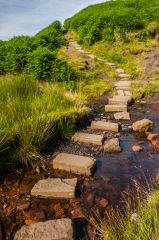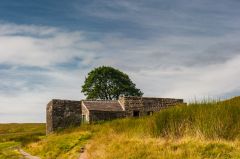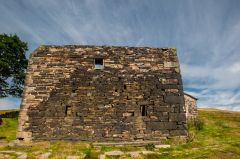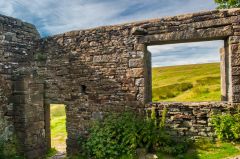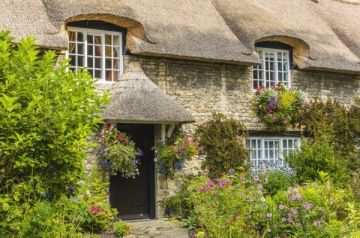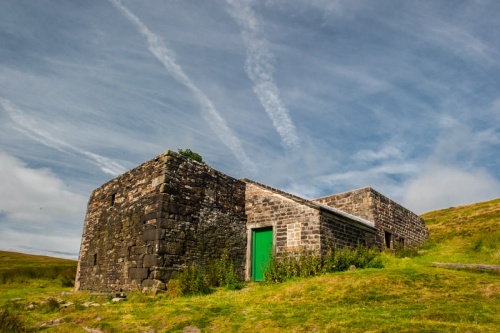
The ruined farmhouse of Top Withens stands in a remote and starkly beautiful moorland setting over 3 miles west of Haworth, in the very heart of Bronte Country. The farm is traditionally said to have inspired Emily Bronte's novel Wuthering Heights.
History
The story of Top Withens farm goes back to at least the late 16th century. In 1591 a farmer named William Bentley divided his Withens estate between his three sons Martyn, John, and Luke. This division probably marked the creation of three individual farms at Lower, Middle, and Top Withens.
A divided inheritance was common practice in the South Pennine area, but the unfortunate side effect of the practice was that each generation was forced to make do with less and less land. The consequence was growing poverty and great hardship.
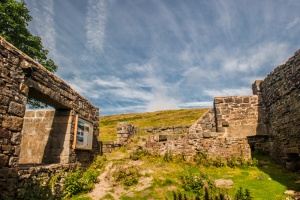
Most farms relied on dairy farming for the bulk of their income, but those nearest the moors also kept sheep, while setting aside small tracts of land for pasture and cattle meadows, and to grow oats.
The meagre living scratched from the earth by moorland farming families was never enough to thrive, and most would have relied on quarrying and weaving to supplement the family income. The Worth Valley surrounding Top Withens is dotted with old quarry sites.
As far as we know, the Bentley family relied on weaving to augment their farming income. They would have transported finished woven goods to market in Halifax or Bradford, over miles of rugged moorland.
The farms at Withens were continuously occupied until shortly after 1890. In 1903-4 the Keighley Corporation bought the now decaying farms. In 1930 the farm buildings at Lower and Middle Withens were pulled down, and the doors and windows of Top Withens were blocked to counter vandalism.
The result is a roofless ruin, with the walls standing to full height on the eastern side, but reduced to crumbling foundations on the west. Outside the intact south doorway is a plaque erected by the Bronte Society, reading;
This farmhouse has been associated with 'Wuthering Heights', the Earnshaw home in Emily Bronte's novel. The buildings, even when complete, bore no resemblance to the house she described, but the situation may have been in her mind when she wrote of the moorland setting of the Heights.
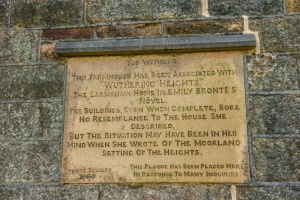
Is Top Withens the real Wuthering Heights?
As the plaque makes clear, the layout of the farm building is nothing like the house described in the novel. The secluded moorland location, however, might well have inspired her description. The Bronte siblings enjoyed walks in the countryside surrounding their Haworth home, and would certainly have been aware of Top Withens farm.
There is no concrete evidence to support the claim that the farm was the 'original' Wuthering Heights, but if it is not, it is certainly the type of place that Emily Bronte had in mind when she wrote her famous novel.
Getting There
Despite the fact that the farm is located directly on the Pennine Way, the most popular route to Top Withens is along the Bronte Way trail, signposted from Haworth. From the Bronte Parsonage Museum, the trail heads up West Lane, then branches onto Cemetery Road at the western edge of Haworth. The views north across the valley are quite superb at this point.
Along Cemetery Road are several laybys where you can park if you want to make your walk shorter. At the end of Cemetery Road just cross the tarmac to another rough parking area, where many people choose to start their walk.
From the parking area, the route is quite easy to follow. Just carry on along the open ridge past several houses and a ruined farm building. at length you leave civilisation behind and find yourself on a trail that runs along the southern slopes of Enshaw Knoll, following South Dean Beck.
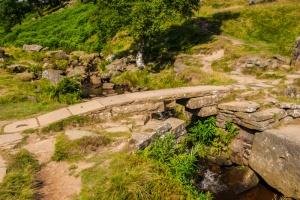
Bronte Bridge and Falls
After two miles, the trail drops down to Bronte Bridge, a stone clapper bridge across the beck. The water tumbles over a small series of rocks above and below the bridge. The area is somewhat optimistically known as Bronte Falls; it isn't really a waterfall but is a wonderfully picturesque spot and a popular area for picnics.
The bridge itself is not one the Brontes would have known. The original stone bridge was swept away in a flash flood in 1989 and replaced the following year by the present bridge.
From Bronte Bridge, it is a simple matter of following the Bronte Way up the far slope and following the well-trodden trail around Scar Hill. The distant ruin of Top Withens will soon appear in the distance, marked by a solitary tree that hovers over the farm building. The trail is very clear along the entire route and well-signposted in both English and Japanese.
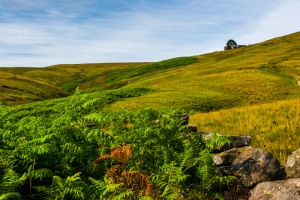
Yes, the trail, and the sites associated with the Bronte sisters, are so popular with Japanese visitors that signs are in both languages.
Once you've explored the ruins you can return the same way or follow the Pennine Way, with takes a more northerly route along the moors towards the village of Stanbury. From Stanbury, you have to walk along the minor road into Haworth. The Bronte Way route is approximately 3.5 miles from Haworth, making a round trip of seven miles. Or, if you have a car and can park at the end of Cemetery Road you can cut two miles off the round trip distance.
We've walked the route both ways; from Haworth and from Stanbury, and either way the scenery is simply stunning. The sheer dramatic desolation and empty expanse of the moorland setting really bring home vividly the scenery described in Wuthering Heights.
About Top Withens
Address: Pennine Way,
Haworth,
Yorkshire,
England
Attraction Type: Historic Building
Location: On the Pennine Way near Haworth. Well signposted from the end of Cemetery Road and along the Pennine Way and Bronte Way trails.
Location map
OS: SD981353
Photo Credit: David Ross and Britain Express
HERITAGE
 We've 'tagged' this attraction information to help you find related historic attractions and learn more about major time periods mentioned.
We've 'tagged' this attraction information to help you find related historic attractions and learn more about major time periods mentioned.
Find other attractions tagged with:
NEARBY HISTORIC ATTRACTIONS
Heritage Rated from 1- 5 (low to exceptional) on historic interest
Bronte Parsonage Museum - 3.2 miles (Museum) ![]()
Haworth, St Michael's Church - 3.2 miles (Historic Church) ![]()
Gibson's Mill - 3.5 miles (Historic Building) ![]()
Hardcastle Crags - 3.6 miles (Countryside) ![]()
East Riddlesden Hall - 7.4 miles (Historic House) ![]()
Pendle Heritage Centre - 7.8 miles (Historic Building) ![]()
Towneley Hall Art Gallery and Museum - 8.4 miles (Museum) ![]()
Burnley, St Peter's Church - 8.7 miles (Historic Church) ![]()

